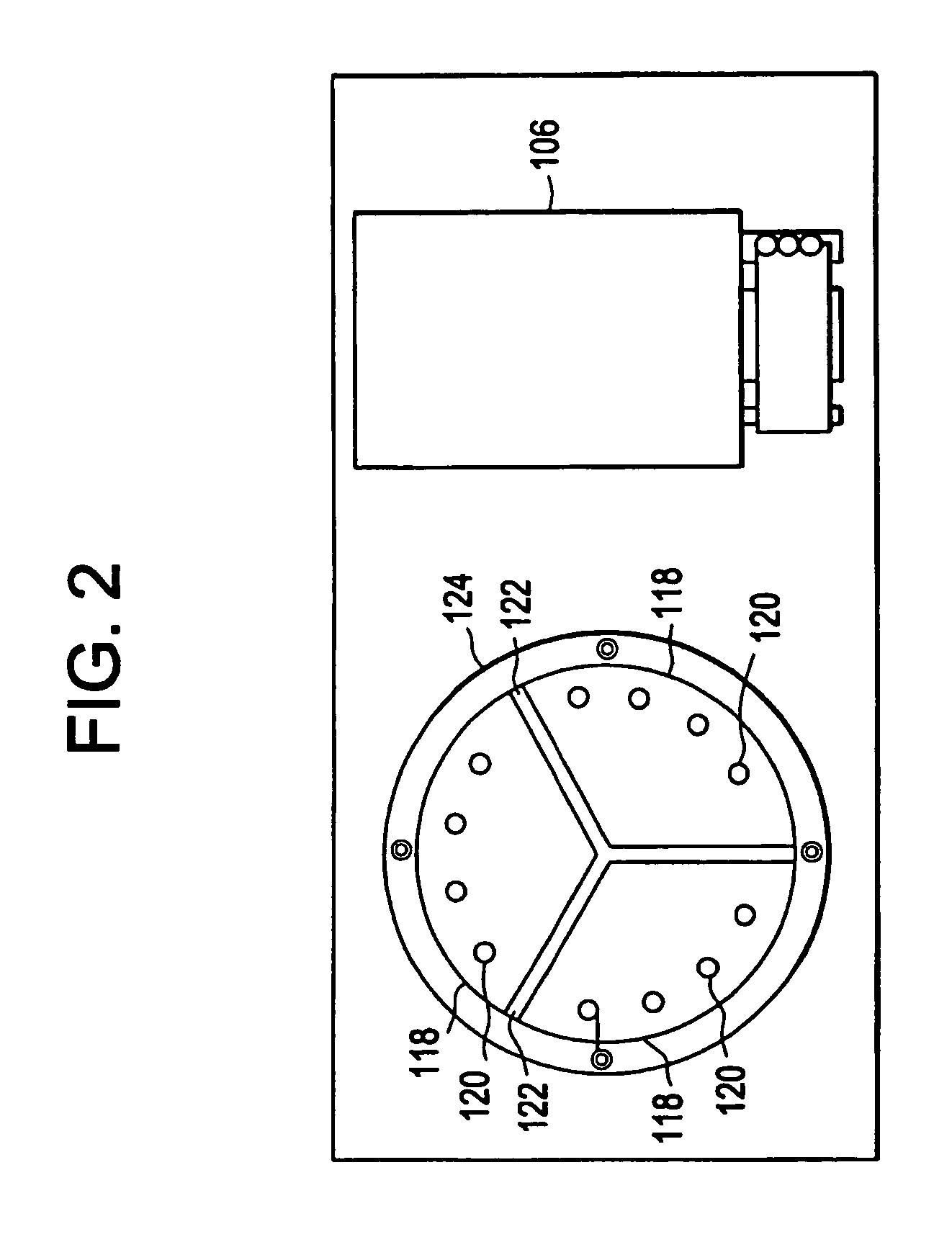Method for a continuous rapid thermal cycle system
a rapid thermal cycle and thermal cycle technology, applied in the direction of fluid controllers, biochemical equipment and processes, fermentation, etc., can solve the problems of inability to easily and quickly adapt to the device, the device is not designed to produce mass quantities of dna, and the time-consuming and laborious processes of the process, so as to improve the specificity and yield of the reaction, minimize thermal transfer, and achieve efficient and maintained
- Summary
- Abstract
- Description
- Claims
- Application Information
AI Technical Summary
Benefits of technology
Problems solved by technology
Method used
Image
Examples
example 1
[0062]A sample was prepared containing: 12% MgCl2 (25 mM), 0.33% Taq DNA polymerase (5 units / μl), 2.0% dNTP's (deoxyadenosine triphosphate (dATP), deoxycytidine triphosphate (dCTP), deoxyguanosine triphosphate (dGTP) and deothythimidine triphosphate (dTTP), 8.0% template (2 μg / ml), 61.66% Pluronic F108 solution (1.5% solution), 4% forward primer, 4% reverse primer, 8% reaction buffer (10× concentration). The solution can be scaled up to the correct volume using these figures. The twelve vertical sectors 118 of the cylindrical temperature control body 102 were heated to three different temperatures, four adjacent sectors 118 were heated to 95° C., another four adjacent sectors 118 were heated to 59° C., and the final four adjacent sectors 118 were heated to 72° C. 1 / 32″ ID, 1 / 16″ OD TEFLON PTFE tubing was wrapped around the temperature control body 102 thirty times to subject the length of tubing 126 and reaction mixture to the three different temperatures thirty different times in s...
example 2
[0068]A reaction mixture with Pluronic is constructed by mixing 3% weight / volume Pluronic F127 with water and adding this to the PCR reaction mix, resulting in the following concentrations:
[0069]
% ofConcentration ofFinalReagentStock SolutionSolutionMilliQ Water79.9%Pluronic F127Add 3% powder to 3%solutionwater to dissolve,slightly increasingvolumePCR Buffer (matched 10X 10%to enzyme bymanufacturer)pGEM 3ZF+ plasmid 5 milligram / 0.06%milliliterMgCl2150 milliMolar 2%Primer forward 20 microMolar 2%CGATTTCGGCCTATTGGTTA(SEQ ID NO: 1)Primer Reverse 20 microMolar 2%CGGTGAAAACCTCTGACACA(SEQ ID NO: 2)Taq DNA polymerase 5 units / microliter 0.6%Deoxynucleotide Mix 10 micromole each 2%nucleotide 100%
[0070]The PCR mixture is kept chilled before it is pumped through the machine and after collection. The machine uses thirty wraps of PFTE tubing with 1 / 16 inch ID and ⅛ inch OD. The PCR mix is made in volumes up to 500 ml and kept at 4 degrees Centigrade prior to cycling. The sectors of t...
example 3
[0071]A range of Pluronic concentrations are described using the same DNA template, oligonucleotide primers and temperature / flow concentrations as in Example 2 with a reaction mixture with Pluronic F108 that is constructed by mixing 1.5% weight / volume Pluronic F108 with water and adding this to the PCR reaction mixture with the amount of MilliQ water varying to bring the final volume to 100%.
[0072]
% ofConcentration ofFinalReagentStock SolutionSolutionMilliQ Water 64%-0%Pluronic F108Add 1.5% powder to 8%-72%water to dissolvePCR Buffer (matched 10X 8%to enzyme bymanufacturer)pGEM 3ZF+ plasmid0.1 milligram / 8%milliliterMgCl2 25 milliMolar 12%Primer forward 10 microMolar 4%CGATTTCGGCCTATTGGTTA(SEQ ID NO: 1)Primer Reverse 10 microMolar 4%CGGTGAAAACCTCTGACACA(SEQ ID NO: 2)Taq DNA polymerase 5 units / microliter0.33%Deoxynucleotide Mix 10 micromole each 2%nucleotide 100%
[0073]The PCR mixture is kept chilled before it is pumped through the machine and after collection. The mach...
PUM
| Property | Measurement | Unit |
|---|---|---|
| temperature | aaaaa | aaaaa |
| temperature | aaaaa | aaaaa |
| temperature | aaaaa | aaaaa |
Abstract
Description
Claims
Application Information
 Login to View More
Login to View More - R&D
- Intellectual Property
- Life Sciences
- Materials
- Tech Scout
- Unparalleled Data Quality
- Higher Quality Content
- 60% Fewer Hallucinations
Browse by: Latest US Patents, China's latest patents, Technical Efficacy Thesaurus, Application Domain, Technology Topic, Popular Technical Reports.
© 2025 PatSnap. All rights reserved.Legal|Privacy policy|Modern Slavery Act Transparency Statement|Sitemap|About US| Contact US: help@patsnap.com



